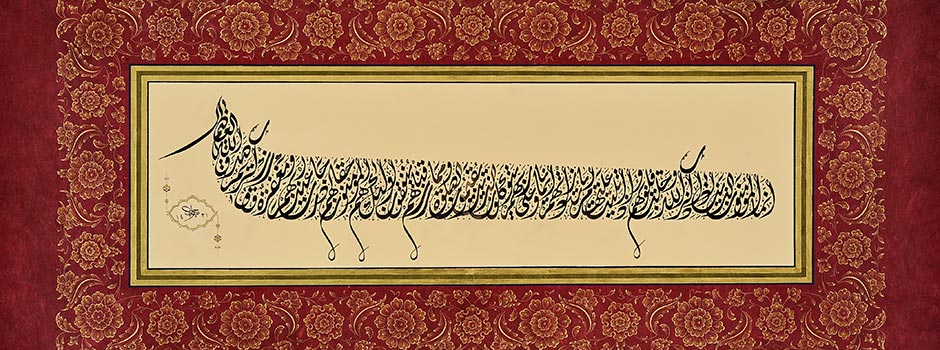
CALLIGRAPHY Hasan Çelebi: A Distinguished Representative of Traditional Calligraphy
Jul 04, 2017 Calligraphy

This article is a part of the project 'Promotion of the Ottoman Cultural Heritage of Bosnia and Turkey' which is organized by Monolit, Association for Promoting Islamic Arts and supported by the Republic of Turkey (YTB - T.C. BAŞBAKANLIK Yurtdışı Türkler ve Akraba Topluluklar Başkanlığı / Prime Ministry, Presidency for Turks Abroad and Related Communities).
 Hasan Çelebi presenting his work to Turkish President Recep Tayyip Erdogan / Courtesy of the artist
Hasan Çelebi presenting his work to Turkish President Recep Tayyip Erdogan / Courtesy of the artist
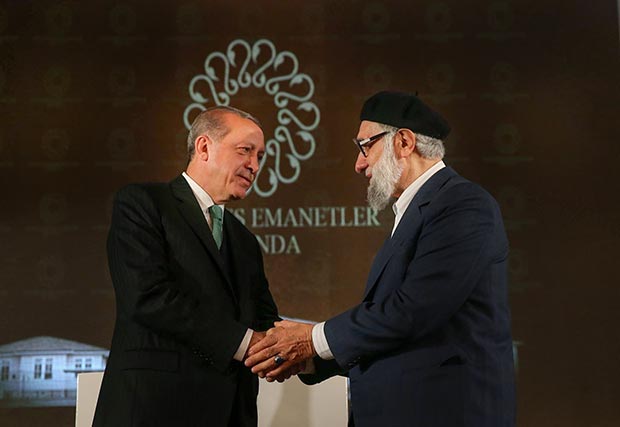 Hasan Çelebi shaking hands with Turkish President Recep Tayyip Erdogan / Courtesy of the artist
Hasan Çelebi shaking hands with Turkish President Recep Tayyip Erdogan / Courtesy of the artist
Istanbul, a blessed city which has made its mark in history by hosting the tradition of writing Qur’an, has been the center, for centuries, of the Ottoman school of calligraphy that was established by Shaykh Hamdullah, a leading calligrapher of the sixteenth century. Though the Turkish alphabet revolution in 1928 led this art to be marginalized in modern Turkey, Istanbul still continued to be the center of that Ottoman calligraphy school. Upon the death of Hamid Aytaç, the last representative of the school in his time, in 1982, those who were familiar with his works thought that this art would no longer be revived in this country. However, it was Hasan Çelebi, the best and most famous student of Hamid Aytaç, that revived this art, just as Phoenix obtains new life by rising from its ashes. Before his death, Hamid Aytaç, the last representative of the Ottoman calligraphy tradition, said: “Let Hafiz Hasan [Çelebi] write the inscription of my gravestone.†This, in fact, was a huge responsibility given to him to carry the tradition of calligraphy to the future. In other words, that request was as if Hamid Aytaç gave, in his style, Hasan Çelebi the permission to represent the Ottoman school of calligraphy after him. In this respect, it is hardly possible to ignore the importance of Hasan Çelebi when one deals with the history and development of calligraphy in the modern period. It can be safely said that just as the leading calligraphers including Ibn Mukle, Ali b. Hilal, Yakut-i Müsta’sim, in the formative period of this distinguished art, Hasan Çelebi is the most important milestone of this art in the modern period.
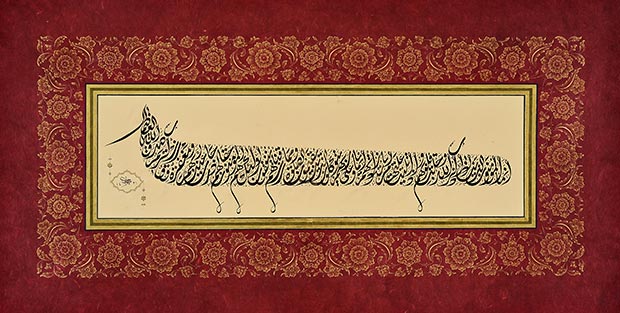 Hasan Çelebi, calligraphy / Courtesy of the artist
Hasan Çelebi, calligraphy / Courtesy of the artist
Born in 1937 in Inci Köyü, a mountain village in Erzurum which was an important center of culture and arts during the Seljuks of Anatolia, Hasan Çelebi had a difficult road to reach his goal of calligraphy. Since his childhood corresponded to the early years of Republican Turkey which was trying to improve its situation after the World War I, he could not receive a good education. The only thing he could do was to memorize the Qur’an. Therefore, like an ant, he had a very long way to reach his aims. Indeed, isn’t it that measurements in the art to which Hasan Çelebi devoted himself are as small as a flea leg or liver? By the Providence of God, he could leave his small village in Anatolia for Istanbul to receive education in the religious sciences. “A poor village boyâ€, as he was called, worked very hard, patiently and steadfastly, as a result of which he could join the Istanbul elite that was raised only within the Ottoman cultural environment. Finally, by producing original works and calligraphies that adorn many mosques across the world, and more importantly, by raising new students, he has established an international school of calligraphy that marks an important step in the history of calligraphy. Being on the footsteps of the tradition, this school envisions a better future for this art.
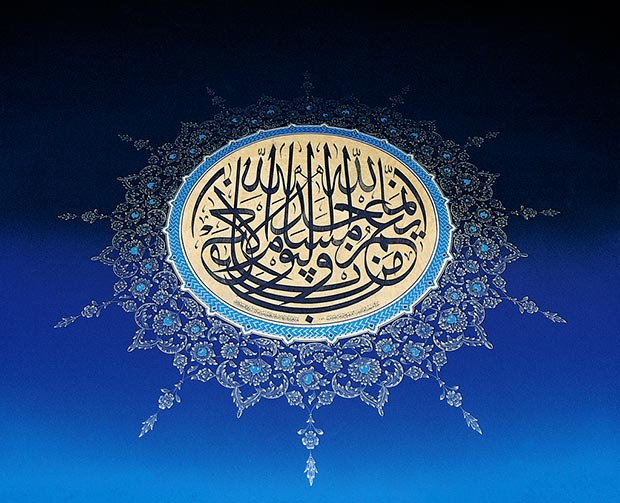 Hasan Çelebi, calligraphy / Courtesy of the artist
Hasan Çelebi, calligraphy / Courtesy of the artist
From an early age, he had a passion for pen and paper, starting his life of calligraphy by emulating calligraphy works he saw at the mosque in his village. Though it took a long time for him to realize that calligraphy is an art, which could be learned only through a serious education, Hasan Çelebi did not give up his passion and love for this art. That passion was so big that, as he stated, “I could not focus on my prayers while praying at Ottoman imperial mosques, just because I was under a spell of the beauty of the calligraphies there.†During his duty as an imam at a mosque in Uskudar, he used to visit a gravestone atelier to watch admiringly gravestones inscribed with beautiful calligraphies. The master of the atelier realized Hasan Çelebi’s interest and skill in this art, so he introducing him to Halim Özyacı and Hamid Aytaç, two leading calligraphers of the time, which were educated during the Ottoman period. The year was 1964. Finally, the lover, Hasan Çelebi, could reach his beloved, the art of calligraphy. Since then, his life has changed dramatically.
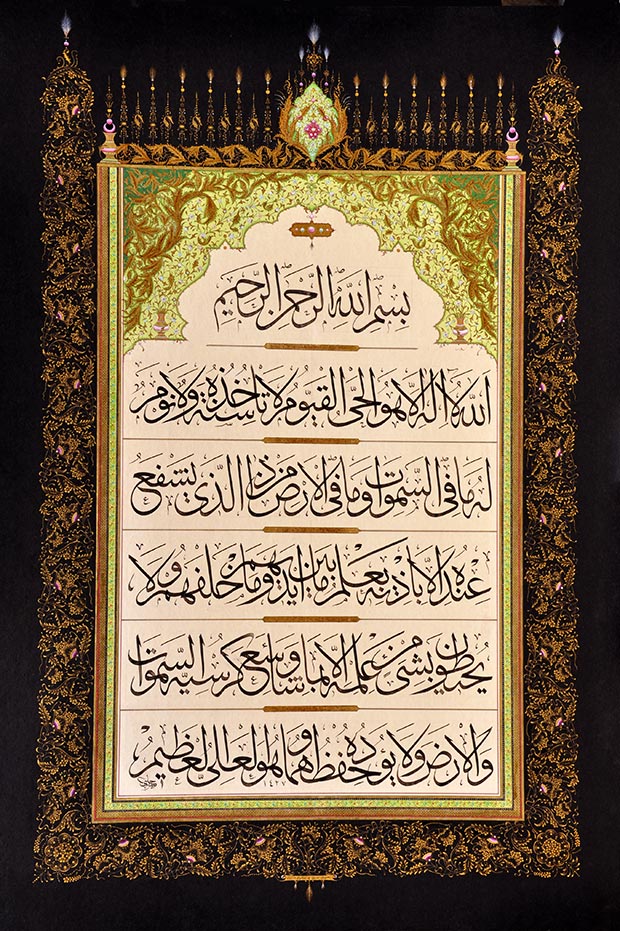 Hasan Çelebi, calligraphy / Courtesy of the artist
Hasan Çelebi, calligraphy / Courtesy of the artist
Having received an ijaza in thuluth and naskh scripts from Hamid Aytaç, and another one in ta’liq and riq’a scripts from Kemal Batanay, Hasan Çelebi has educated the second largest number of students, after his teacher Hamid Aytaç, in modern Turkey. Since 1976, he has taught calligraphy, and has given ijaza to more than ninety students from all around the world, including the US, Japan, Russia, Bosnia and South Africa. As an exceptional calligrapher who raised brilliant students, he produced unique works which can be found in many mosques around the world, and in special collections. His fame extends beyond Turkey, becoming a well-known artist in international cultural and art centers.
In the arts, raising students is as important as producing works, as it is the only way of maintaining the future of the arts. Therefore, artists’ accomplishments have been assessed not only with their admirable works, but also with students they raised. During his 52-year life of calligraphy, Hasan Çelebi has worked tirelessly in order to put forth new works, as well as has encouraged numberless people to love and deal with calligraphy. It can be safely said that his well-known students, including Davud Bektaş, Muhammed Zekeriya, Ferhat Kurlu, Fuad Kuchi Honda, Ćazim Hadžimejlić, Ayten Tiryaki, Ayman Hassan, and Betül Utku, are the best works of Hasan Çelebi. By raising students, Hasan Çelebi has fulfilled a crucial mission of sustaining the transmission chain of this traditional art.
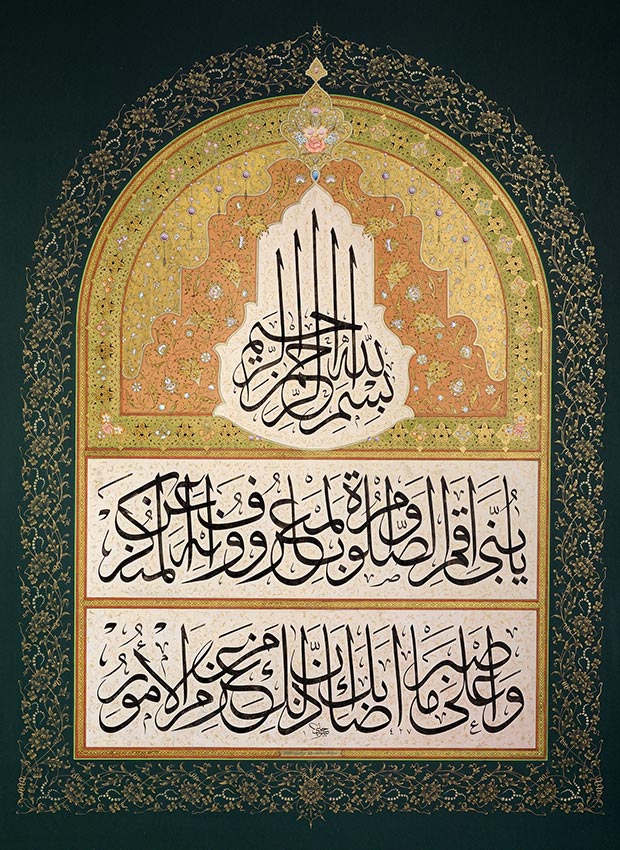 Hasan Çelebi, calligraphy / Courtesy of the artist
Hasan Çelebi, calligraphy / Courtesy of the artist
Hasan Çelebi still continues producing new works. Calligraphers that were raised in the last century have a special characteristic that they can write in all scripts. Hasan Çelebi is one of them. He produced works in thuluth, naskh, ta’liq, diwani, jali diwani, muhaqqaq, and riq’a, which are considered as the classical styles of writing, as well as in kufi script. However, the script in which Hasan Çelebi produced the largest number of works is jali thuluth. Though the value of an artist should not be judged with the number of works he or she produce, Hasan Çelebi produced a large number of works, all of which are qualified. Among his works, calligraphies written for mosques have a special place. Almost 100 mosques in Turkey and beyond, including Kuba Mosque in Saudi Arabia, Erzurum Atatürk University Mosque, Kayseri Erciyes University Mosque, old mosques in Marmara University’s Faculty of Theology, mosques in South Africa, Sarajevo, Kazakystan, and Tataristan, are adorned with his beautiful calligraphies. Today, in Turkey, most of the mosques that were renovated, as well as the ones newly built have inscriptions written by him in jali script.
In his current project he and some of his students are preparing calligraphies for Istanbul Çamlica Mosque, whose construction will be completed soon thanks to the Turkish President Recep Tayyip Erdogan’s pioneering support. His work for this mosque will be indeed his masterpiece. It can be said that his style of using jali thuluth is unique. His skill in using this script can be seen in another form of writing, namely tughra, which was indeed better known as a signature of Ottoman sultans, but some calligraphers, including Hasan Çelebi, in the last century produced their works in this form. Having written tughras for many statesmen, Hasan Çelebi continues to use classical form of writing in his works including 270 hilyes, classical plates, and other types of compositions. His exceptional skill manifested itself in his rich and diverse collection that combines traditional calligraphy with various forms of composition. It would not be an exaggeration that the length of his works in total could be many kilometers. His inscription for the Quba Mosque in Medina alone is 1640 meters. He dedicated all his life to the development of calligraphy, and finally he was honoured with the most prestigious award (Sanata Üstün Hizmet Büyük Ödülü) under the Turkish Presidency, by the then president, Abdullah Gül.
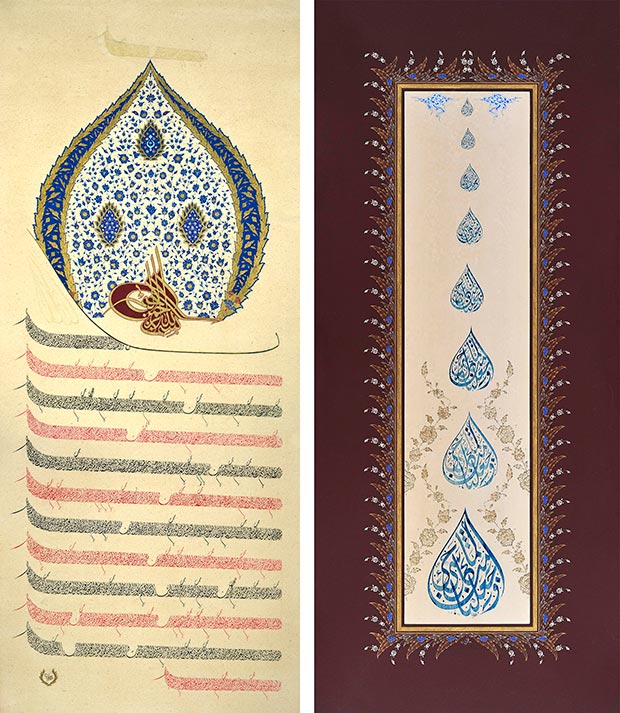 Hasan Çelebi, calligraphy works in the form of tughra / Courtesy of the artist
Hasan Çelebi, calligraphy works in the form of tughra / Courtesy of the artist
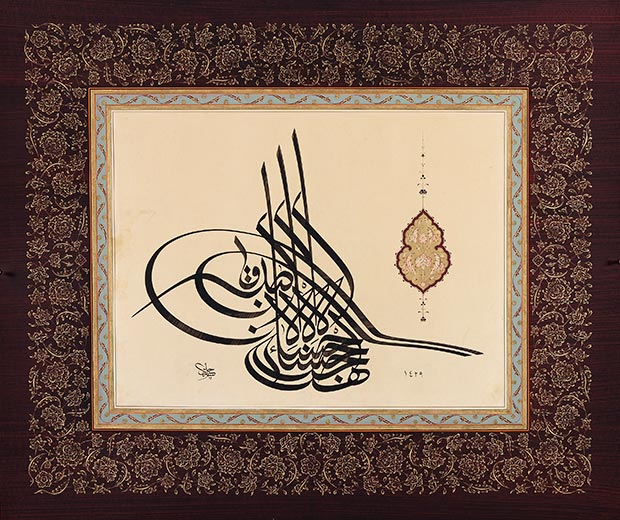 Hasan Çelebi, calligraphy in the form of tughra / Courtesy of the artist
Hasan Çelebi, calligraphy in the form of tughra / Courtesy of the artist
He is not categorically opposed to modern applications of calligraphy, but he is a firm follower of classical tradition. Some of his works admiringly represent a successful synthesis of the classical with the modern writing styles. In other words, he is a strict follower of the rules of classical composition, but he sometimes uses different forms of composition. According to Hasan Çelebi, calligraphy has a classical and traditional essence, which should not disappear. He emphasizes that there are many things to do in this field, as it has not reached its saturation point yet. There is a wide range of opportunities that allow volunteers of this art to enrich it.
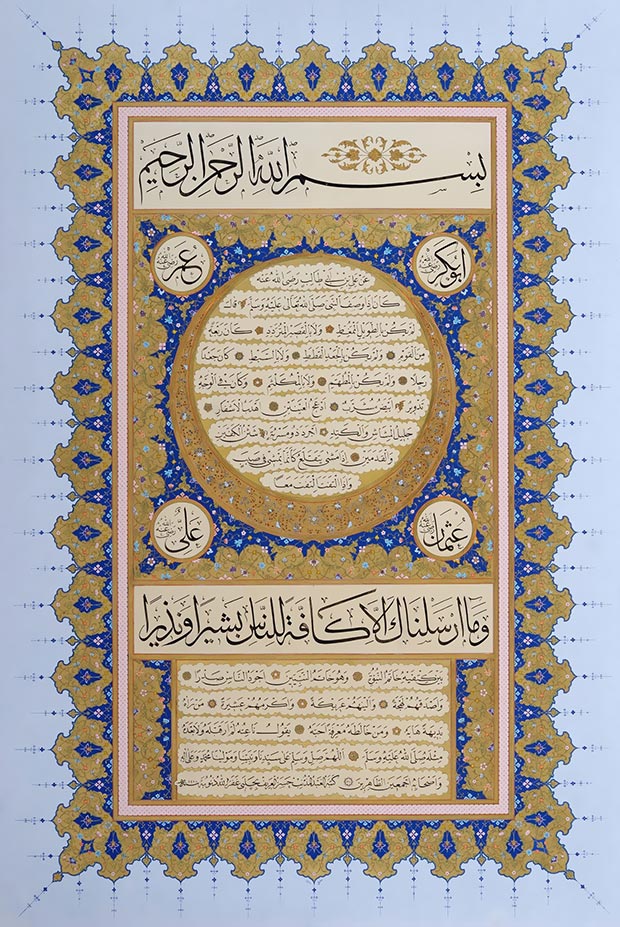 Hasan Çelebi, Hilye-i-Sharif / Courtesy of the artist
Hasan Çelebi, Hilye-i-Sharif / Courtesy of the artist
Hasan Çelebi has never been selfish in his artistic life. Since his childhood, he has always been moderate and gracious. He treats his students with kindness. His surname Çelebi literally means gentleman in Turkish, which exactly defines who Hasan Çelebi is. He does not like to impose rules on others. His way of educating students is so eloquent that nobody takes his corrections personally. Protecting and encouraging students belong to his generosity and tolerant personality. His life is so filled with calligraphy which necessitates a big patience, that it becomes an essential part of his character. In other words, it would not be an exaggeration to say that Hasan Çelebi has reached the nirvana in calligraphy or fanÄ fÄ« al-khatt (annihilation in calligraphy). It is a big honour for me to be one of his students.
Comments
Add a comment